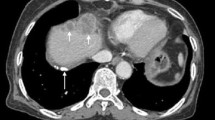Abstract
A 68-year-old woman presented with abdominal pain, weight loss, and vomiting. Enhanced computed tomography (CT) showed slightly increased density in the mesentery and edema of the third portion of the duodenum and proximal jejunum. Little ascites, but no primary lesion, lymph node metastases, or distant metastases, were observed. Endoscopic findings included erythema and edema in the distal duodenum and proximal jejunum without epithelial lesions. Double-contrast radiography revealed transverse ridging with convergence, suggesting a serosal lesion. We suspected disease involving the serosa, such as mesenteric panniculitis. However, the lesion was definitively diagnosed as malignant peritoneal mesothelioma based on a biopsy specimen obtained at laparotomy. The combination of transverse ridging with convergence on double-contrast radiography and mucosal edema without epithelial lesions on endoscopy was consistent with a disorder involving the serosa. Transverse ridging with convergence is helpful to diagnose serosal pathology such as malignant peritoneal mesothelioma. Combining the findings of double-contrast radiography and endoscopy with computed tomography may facilitate diagnosis of malignant peritoneal mesothelioma. Thus, in case of increased density of mesentery and wall thickness on CT image with transverse ridging with convergence on double-contrast radiography and without epithelial lesion on endoscopy, malignant peritoneal mesothelioma must be considered.







Similar content being viewed by others
References
Park JY, Kim KW, Kwon HJ, et al. Peritoneal mesotheliomas: clinicopathologic features, CT findings, and differential diagnosis. AJR Am J Roentgenol. 2008;191:814–25.
Pickhardt PJ, Bhalla S. Primary neoplasms of peritoneal and sub-peritoneal origin: CT findings. Radiographics. 2005;25:983–95.
Antman KH. Current concepts: malignant mesothelioma. N Engl J Med. 1980;303:200–2.
Rodríguez D, Cheung MC, Housri N, et al. Malignant abdominal mesothelioma: defining the role of surgery. J Surg Oncol. 2009;99:51–7.
Moolgavkar SH, Meza R, Turim J. Pleural and peritoneal mesotheliomas in SEER: age effects and temporal trends, 1973–2005. Cancer Causes Control. 2009;20:935–44.
Selikoff IJ, Churg J, Hammond EC. Relation between exposure to asbestos and mesothelioma. N Engl J Med. 1965;272:560–5.
Nakashima K, Inatsu H, Kitamura K, et al. Advanced diffuse malignant peritoneal mesothelioma responding to palliative chemotherapy. Clin J Gastroenterol. 2012;5:373–6.
Kaya H, Sezgı C, Tanrıkulu AC, et al. Prognostic factors influencing survival in 35 patients with malignant peritoneal mesothelioma. Neoplasma. 2014;61:433–8.
Alexander HR Jr, Burke AP. Diagnosis and management of patients with malignant peritoneal mesothelioma. J Gastrointest Oncol. 2016;7:79–86.
Baratti D, Kusamura S, Martinetti A, et al. Prognostic value of circulating tumor markers in patients with pseudomyxoma peritonei treated with cytoreductive surgery and hyperthermic intraperitoneal chemotherapy. Ann Surg Oncol. 2007;14:2300–8.
Munkholm-Larsen S, Cao CQ, Yan TD. Malignant peritoneal mesothelioma. World J Gastrointest Surg. 2009;30:38–48.
Que Y, Wang X, Liu Y, et al. Ultrasound-guided biopsy of greater omentum: an effective method to trace the origin of unclear ascites. Eur J Radiol. 2009;70:331–5.
Cerruto CA, Brun EA, Chang D, et al. Prognostic significance of histomorphologic parameters in diffuse malignant peritoneal mesothelioma. Arch Pathol Lab Med. 2006;130:1654–61.
Husain AN, Colby TV, Ordóñez NG, et al. Guidelines for pathologic diagnosis of malignant mesothelioma: a consensus statement from the International Mesothelioma Interest Group. Arch Pathol Lab Med. 2009;133:1317–31.
Lee M, Alexander HR, Burke A. Diffuse mesothelioma of the peritoneum: a pathological study of 64 tumours treated with cytoreductive therapy. Pathology. 2013;45:464–73.
Liu S, Staats P, Lee M, et al. Diffuse mesothelioma of the peritoneum: correlation between histological and clinical parameters and survival in 73 patients. Pathology. 2014;46:604–9.
Daskalogiannaki M, Voloudaki A, Prassopoulos P, et al. CT evaluation of mesenteric panniculitis: prevalence and associated diseases. AJR Am J Roentgenol. 2000;174:427–31.
Selikoff IJ, Hammond EC, Seidman H. Latency of asbestos disease among insulation workers in the United States and Canada. Cancer. 1980;46:2736–40.
Acknowledgement
We would like to thank Dr. Takihiro Kamio at Saiseikai Kumamoto Hospital for valuable advice on pathological findings and Dr. Aya Kataoka, Dr. Kouichi Matsumoto, Dr. Hibiki Ohtani, and Dr. Yasushi Yoshida at Kumamoto Chuo Hospital for their assistance in examination or operation.
Author information
Authors and Affiliations
Corresponding author
Ethics declarations
Conflict of interest
The authors declare that they have no conflict of interest.
Human rights
All procedures followed have been performed in accordance with the ethical standards laid down in the 1964 Declaration of Helsinki and its later amendments.
Informed consent
Informed consent was obtained from all patients for being included in the study.
Rights and permissions
About this article
Cite this article
Saito, H., Hasuda, S., Nasu, J. et al. A case of malignant peritoneal mesothelioma suggesting the utility of combining double-contrast radiography and endoscopy with computed tomography for diagnosis. Clin J Gastroenterol 10, 371–376 (2017). https://doi.org/10.1007/s12328-017-0757-9
Received:
Accepted:
Published:
Issue Date:
DOI: https://doi.org/10.1007/s12328-017-0757-9




